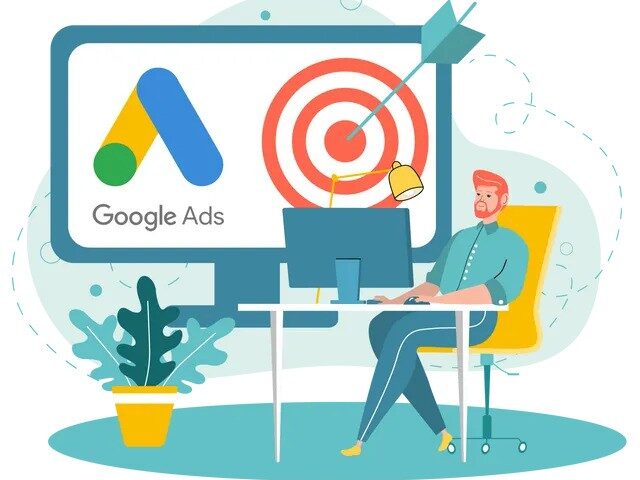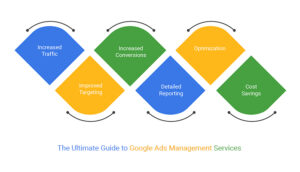Google Ads Services
- Home
- Google Ads Services

Google Ads Services cater to businesses looking to leverage online advertising through Google’s platform to reach potential customers and boost their online visibility. With a wide range of ad formats and targeting options, Google Ads Services help businesses generate leads, increase website traffic, and drive sales.
The platform allows advertisers to create and manage campaigns that align with their specific marketing objectives, whether it’s increasing brand awareness or driving app installs. Additionally, Google Ads Services provide valuable insights through detailed analytics and reporting, enabling businesses to track the performance of their ads and optimize their overall advertising strategy for better results.
Types Of Google Ads
When running a Google Ads campaign, it’s essential to understand the different types of ads available. Each type serves a unique purpose and can be deployed based on your specific marketing goals. In this section, we will delve into the various types of Google Ads, including Search Ads, Display Ads, Video Ads, shopping ads, and app ads.
Search Ads
Search Ads are text ads that appear above or below Google search results when users look for specific products, services, or information. They are an effective way to capture potential customers at the moment they are actively searching for something relevant to your business.
Display Ads
Display Ads are visually engaging and appear on websites, videos, and apps within the extensive Google Display Network. These ads can include images, videos, or rich media and are designed to increase brand awareness and reach potential customers across various digital platforms.
Video Ads
Video Ads are displayed before, during, or after YouTube videos and across the Google Display Network. They allow businesses to showcase their products or services through engaging video content, increasing brand awareness and driving engagement.
Shopping Ads
Shopping Ads appear at the top of Google search results when users search for products to purchase. These ads include essential product information such as images, prices, and store names, making them highly effective for e-commerce businesses aiming to drive direct product sales.
App Ads
App Ads are designed to promote mobile apps within other apps across the Google Network. These campaigns help drive installations and engagement for mobile applications, making them an essential tool for app developers and marketers. The diverse range of Google Ads types provides businesses with numerous avenues to reach their target audience and achieve their marketing objectives.
Benefits Of Using Google Ads
When it comes to digital advertising, Google Ads services offer a multitude of benefits for businesses looking to increase brand visibility, reach targeted audiences, measure results, and manage their budget effectively. Understanding the advantages of using Google Ads can help businesses make informed decisions about their online advertising strategies.
Increased Brand Visibility
By using Google Ads, businesses can significantly boost their brand visibility by appearing at the top of search engine results pages. This prime placement ensures that potential customers are more likely to notice and click on the advertised link, leading to increased website traffic and brand exposure.
Targeted Advertising
Google Ads provides the ability to target specific demographics, locations, and keywords, allowing businesses to reach their ideal audience with precision. This targeted approach ensures that ad spend is focused on reaching the most relevant potential customers, resulting in higher conversion rates.
Measurable Results
One of the key advantages of Google Ads is the ability to measure the performance of ad campaigns in real time. Businesses can track metrics such as clicks, impressions, and conversions, allowing for data-driven optimization and continuous improvement of advertising strategies.
Cost-effective
With Google Ads, businesses have the flexibility to set their budget based on their advertising goals. The pay-per-click model ensures that advertisers only pay when their ad is clicked, making it a cost-effective option for businesses of all sizes and budgets.
Flexible Budgeting
Google Ads allows businesses to easily adjust their advertising budget and bids, providing the flexibility to allocate resources where they are most effective. This agility enables businesses to optimize their campaigns and maximize their return on investment.
Setting Up A Google Ads Campaign
Setting up a Google Ads campaign is an essential step in reaching your target audience and promoting your products or services effectively. With Google Ads Services, you have the opportunity to create campaigns that drive traffic and conversions to your website. But where do you start? Let’s break it down into clear and actionable steps to help you get started.
Defining Campaign Goals
Before diving into the nitty-gritty of setting up your Google Ads campaign, it’s important to define your goals. What do you aim to achieve through your campaign? Are you interested in increasing brand awareness, generating leads, or driving sales? Defining your campaign goals allows you to tailor your strategy and optimize your ads accordingly.
Keyword Research
Once you’ve determined your campaign goals, the next step is conducting thorough keyword research. Keywords are the building blocks of your Google Ads campaign as they help you target specific queries that users are searching for. Put yourself in your customers’ shoes and think about the words they would use when searching for products or services similar to yours. By identifying relevant and high-intent keywords, you can optimize your campaign’s performance and generate quality leads.
Creating Ad Groups
Creating well-organized ad groups is crucial for maximizing the effectiveness of your Google Ads campaign. Ad groups enable you to group together similar keywords and tailor your ads to specific audience segments. This allows you to deliver highly targeted and relevant ads that resonate with your potential customers. Remember to create ad groups that align with your campaign goals and provide a clear structure for your ads.
Writing Compelling Ad Copy
When it comes to Google Ads, having compelling ad copy can make or break your campaign’s success. Your ad copy should be concise, engaging, and appeal to the needs and desires of your target audience. Highlight the unique selling points of your products or services and use persuasive language to entice potential customers to click on your ads. Crafting compelling ad copy increases the chances of driving qualified traffic to your website and maximizing your campaign’s return on investment.
Setting Bids And Budget
Setting bids and budget is a critical step in managing your Google Ads campaign effectively. Bids determine how much you are willing to pay for each click on your ads, while budget sets the limit on how much you are willing to spend on your campaign per day. It’s important to strike a balance between bidding competitively to ensure ad visibility and staying within your allotted budget. Regularly monitor and adjust your bids and budget to optimize your campaign’s performance and achieve your desired results.
Optimizing Google Ads Campaigns
When it comes to running successful Google Ads campaigns, optimizing your strategies is essential. By constantly monitoring performance metrics, optimizing keyword selection, conducting A/B tests for your ads, adjusting bids and budget, and leveraging ad extensions, you can ensure maximum visibility and ROI for your campaigns.
Monitoring Performance Metrics
Regularly monitoring performance metrics allows you to gain valuable insights into the success of your Google Ads campaigns. By analyzing metrics such as click-through rate, conversion rate, and cost per conversion, you can identify areas that require improvement.
Use the Google Ads interface to access detailed reports on campaign performance. Pay close attention to metrics like impressions, clicks, and conversions to evaluate the effectiveness of your ads. Analyzing this data will help you make informed decisions and allocate your resources more effectively.
Additionally, tracking key metrics will enable you to identify any potential issues quickly. By monitoring performance regularly, you can take proactive measures to optimize your campaigns and ensure their success.
Optimizing Keyword Selection
Selecting the right keywords is crucial for the success of your Google Ads campaigns. To optimize keyword selection, start by conducting thorough research to identify relevant keywords that align with your target audience’s search intent.
Make use of keyword research tools and take into account factors such as search volume, competition, and relevance to your business. It’s important to strike a balance between highly competitive keywords and long-tail keywords, strategically targeting both to reach a broader audience.
Once you’ve chosen your keywords, utilize match types effectively to ensure your ads are triggered for relevant search queries. By including negative keywords, you can filter out irrelevant traffic and improve the overall performance of your campaigns.
A/b Testing Ads
A/B testing is a valuable technique to optimize the performance of your Google Ads campaigns. By creating multiple versions of your ads and testing them against each other, you can identify which elements resonate best with your audience and drive higher click-through rates and conversions.
During A/B testing, focus on testing one element at a time, such as the ad copy, headline, or call-to-action. By keeping all other variables constant, you can accurately measure the impact of each change. Deploy the winning variant and continue testing to consistently optimize your ads.
Adjusting Bids And Budget
Adjusting your bids and budget is a crucial aspect of campaign optimization. Regularly review your bid strategy to ensure you are maximizing the visibility of your ads within your desired budget.
Monitor the performance of your keywords and ads to identify areas with low conversion rates or high costs per click. Consider increasing bids for keywords that drive highly relevant traffic and have a positive impact on your campaign performance. Conversely, decrease bids or exclude keywords that do not generate desired results.
Additionally, optimize your campaign budget to allocate resources to the most effective keywords and ad groups. Shift budget allocation to high-performing areas to maximize your return on ad spend.
Leveraging Ad Extensions
Ad extensions provide additional information and enhanced visibility to your Google Ads. By leveraging ad extensions, you can make your ads more captivating and increase click-through rates.
Ad extensions such as call extensions, sitelink extensions, and location extensions help enhance your ad’s appearance and provide users with more relevant information. Utilize ad extensions strategically to highlight unique selling points, promotions, or contact information.
Regularly monitor the performance of your ad extensions and make necessary adjustments to optimize their effectiveness. Experiment with different extensions and variations to determine which options yield the best results for your campaigns.
Common Mistakes To Avoid
When it comes to running successful Google Ads campaigns, it’s important to avoid common mistakes that can hinder your results. By understanding and avoiding these mistakes, you can optimize your ads, increase your click-through rates, and ultimately maximize your return on investment. In this post, we’ll explore some of the most common mistakes that advertisers make when using Google Ads services and provide actionable tips to help you steer clear of them.
Poor Keyword Selection
One of the key factors in the success of your Google Ads campaign is the selection of relevant keywords. Many advertisers make the mistake of targeting broad keywords that may generate a high volume of impressions but fail to attract qualified traffic. Rather than focusing on generic terms, it’s crucial to conduct thorough keyword research to identify specific, long-tail keywords that align with your target audience’s search intent. By choosing the right keywords, you can ensure your ads appear to the most relevant audience, increasing the chances of conversions.
Lack Of Ad Targeting
In order to reach the right audience, it’s essential to properly define and target your ads. Simply relying on Google’s default targeting options can lead to a wasted budget and inefficient ad spend. Take advantage of advanced targeting features that Google Ads offers, such as location targeting, demographic targeting, and device targeting. By narrowing down your audience and showing your ads to the most relevant prospects, you can improve the quality of your traffic and increase the likelihood of conversions.
Insufficient Tracking And Monitoring
Ignoring the importance of tracking and monitoring your Google Ads campaigns is a common mistake that can hinder your success. Without proper monitoring, you won’t be able to measure the effectiveness of your ads or make informed decisions based on data. Make sure to set up conversion tracking using Google Ads’ conversion tracking tool or Google Analytics. By monitoring your key metrics, such as click-through rates, conversion rates, and cost per conversion, you can identify areas for improvement and make data-driven optimizations to your campaigns.
Ignoring Quality Score
Quality Score is a critical metric that can impact the performance and cost of your Google Ads campaigns. Ignoring your Quality Score can lead to wasted budget and lower ad rankings. Make it a priority to improve your Quality Score by focusing on relevant ad copy, optimized landing pages, and high-quality keywords. By continually refining your campaigns and increasing your Quality Score, you can improve your ad positions, reduce your cost per click, and ultimately achieve better overall campaign performance.
Inadequate Budget Allocation
Another common mistake is allocating an inadequate budget to your Google Ads campaigns. Underestimating the budget required to reach your advertising goals can limit your campaign’s reach and impact. Conduct thorough research and analysis to understand the average costs per click and the competitiveness of your keywords. By allocating a sufficient budget, you can ensure that your ads are seen by your target audience and give your campaigns the best chance of success.

Frequently Asked Questions On Google Ads Services
What Is Google Ads And How Does It Work?
Google Ads is an online advertising platform where businesses can create and display ads on Google’s search results pages and partner websites. It works by using keywords and targeting options to show ads to relevant audiences, and businesses only pay when someone clicks on their ads.
What Are The Benefits Of Using Google Ads?
Using Google Ads can provide several benefits for businesses. It enables them to reach a large audience of potential customers, target specific demographics, track ad performance and make data-driven optimizations, increase brand visibility and awareness, and ultimately drive more traffic and sales.
How Much Does It Cost To Advertise On Google Ads?
The cost of advertising on Google Ads varies depending on several factors, including the competitiveness of the keywords you’re targeting, the quality and relevance of your ads, the targeting options chosen, and your budget. Google Ads operates on a pay-per-click (PPC) model, so you only pay when someone clicks on your ad.
How Can I Improve The Performance Of My Google Ads Campaigns?
To improve the performance of your Google Ads campaigns, you can try several strategies. These include optimizing your keywords and ad copy, testing different ad variations, refining your targeting options, monitoring and analyzing your campaign data, and making data-driven optimizations based on the insights gained.
Conclusion
To sum it up, Google Ads services are essential for businesses of all sizes looking to maximize their online presence and reach their target audience effectively. By leveraging the power of Google’s advertising platform, companies can create tailored campaigns, drive relevant traffic to their websites, and ultimately boost their conversions and revenue.
With its range of targeting options, comprehensive analytics, and continuous optimization possibilities, Google Ads Services offer an unparalleled opportunity for businesses to thrive in the digital landscape. Start using Google Ads Services today and watch your online success soar!

Services
Useful Links
Our Infro
-
OPENING HOURES :
Everyday 10.00 am - 7.00 pm - Email: hello@centerofdigitalmarketing.com
- Phone: +8801325-088851 – 60
- Whatsapp: +8801325-088851
- Address: House #59, Level #7, Road 13, Sector 13, Uttara, Dhaka 1230

Leave A Comment